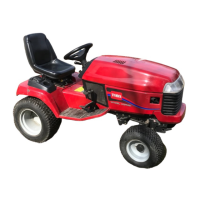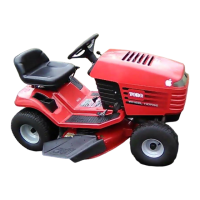Maintenance
34
Fuel
T
ank
Draining The Fuel Tank
POTENTIAL
HAZARD
• In certain conditions gasoline is extremely
flammable and highly explosive.
WHAT CAN HAPPEN
• A fire or explosion from gasoline can burn
you, others, and cause property damage.
HOW TO AV
OID THE HAZARD
• Drain gasoline from the fuel tank when the
engine is cold. Do this outdoors in an open
area. Wipe up any gasoline that spills.
• Never drain gasoline near an open flame or
where gasoline fumes may be ignited by a
spark.
• Never smoke a cigarette, cigar or pipe.
1. Clean area around fuel tank cap so foreign matter
cannot enter filler hole when cap is removed.
Next, remove cap from fuel tank.
2. Using a pump-type syphon, drain gasoline into a
clean gas can.
Note: There is no other recommended way to
drain gasoline from the fuel tank, other
than by using a pump-type syphon. An
inexpensive syphon can be purchased
at a hardware store.
Battery
Service Interval/Specification
Check the electrolyte level in the battery every 5
hours. Always keep the battery clean and fully
charged. Use a paper towel to clean the battery case.
If the battery terminals are corroded, clean them with
a solution of four parts water and one part baking
soda. Apply a light coating of grease to the battery
terminals to prevent corrosion.
Voltage: 12 v, 160 Cold Cranking Amps
Removing the Battery
1. Disengage the power take off (PTO), set the
parking brake, and turn the ignition key to
“OFF” to stop the engine. Remove the key.
2. Remove wing nut securing battery hold downs to
rider chassis (Fig.14).
3. Disconnect the negative (black) ground cable
from the battery post (Fig. 14).
4. Lift the rubber cover up on the positive (red)
cable. Disconnect the positive (red) cable from
the battery post (Fig. 14).
5. Remove wing nut securing battery hold downs to
rider chassis (Fig.14).
6. Lift up on top battery hold down and pivot
rearward
7. Remove battery from chassis.
1
2
2
3
Figure 14
1. Wing
nut
2.
Battery hold down
3. V
ent tube

